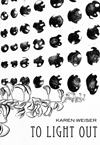To Light Out
So it goes, and a mollusk can not draw
the machine as we can not draw the heart
So it goes, and a mollusk can not draw
the machine as we can not draw the heart
– from “So It Goes” in To Light Out
Karen Weiser’s To Light Out is deceptively slim. In 72 pages of compact poems, an intro and notes, she finds “the angles in language through symbols,” explores Jack Spicer’s metaphor of the poet as radio, quotes from Emanuel Swedenborg’s Heaven and Hell, and meditates on how it feels to be forming new life within her womb – “The static was less a sound than a sense that the flickering of snow on a TV screen had been made into liquid.”
The deft economy of language renders concepts such as the big bang, cell formation, and fugue patterns taut while at the same time connecting complex creations, juxtaposing opposite forces to make sense of both cosmic and earthly chaos. Here we find the furniture/DNA “spiraling into its own pulse” and the universe “is both inanimate and alive.”
At once a heady investigation into cosmological philosophies and a rumination on what it is to be of this organic world of constant decay and rebirth, it is also a celebratory exploration in the delights of language, one in which playfulness and reverence are equal. Closing poem “A Makeshift Symmetry of Cells” tells of possums, nebulas, pianos, circuits, and angels, all in 19 lines. In lesser hands these odd companions could seem like simple gimmicky, in Weiser’s they culminate in an “ethereal pulse.”





